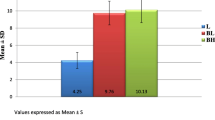Abstract
Purpose
The continuous subcutaneous infusion (CSI) technique is a simple, inexpensive method for managing postoperative pain. We examined the analgesic effects of CSI of buprenorphine in patients undergoing lumbar spinal fusion surgery.
Methods
The patients were randomly assigned to one of three groups for postoperative pain management: control group (n = 17), high-dose buprenorphine group (BH group, n = 17), and low-dose buprenorphine group (BL group, n = 16). Infusion solutions containing buprenorphine at concentrations of 25.0 and 16.7 µg·ml−1 combined with droperidol at a concentration of 52.0 µg·ml−1 were used in the BH and BL groups, respectively; and an infusion solution containing droperidol at a concentration 52.0 µg·ml−1 was used in the control group. CSI of each solution was started at a rate of 1 ml·h−1 and was continued for 48 h.
Results
The BH and BL groups showed significantly lower scores than the control group on the Visual Analogue Scale. There were significantly fewer administrations of flurbiprofen as a supplemental analgesic in the BL and BH groups than in the control group. The incidences of sedation and nausea were comparable in the three groups. The median number of administrations of flurbiprofen was significantly less in the BH group than in the control group on the day of the operation and on the first postoperative day, whereas the number in the BL group was less than that in the C group only on the day of the operation.
Conclusion
CSI of buprenorphine effectively reduces pain after lumbar spinal fusion surgery without apparent side effects. This technique is simple and useful for postoperative pain management.
Similar content being viewed by others
References
PE Macintyre (2001) ArticleTitleSafety and efficacy of patient-controlled analgesia Br J Anaesth 87 36–46
M Choiniere BE Rittenhouse S Perreault D Chartrand P Rousseau B Smith C Pepler (1998) ArticleTitleEfficacy and costs of patient-controlled analgesia versus regularly administered intramuscular opioid therapy Anesthesiology 89 1377–1388
A Jacox DB Carr DM Mahrenholz BM Ferrell (1997) ArticleTitleCost considerations in patient-controlled analgesia Pharmacoeconomics 12 109–120
GM Chumbley GM Hall P Salmon (1998) ArticleTitlePatient-controlled analgesia: an assessment by 200 patients Anaesthesia 53 216–221
SA Coleman J Booker-Milburn (1996) ArticleTitleAudit of postoperative pain control: influence of a dedicated acute pain nurse Anaesthesia 51 1093–1096
TA Goudie MWB Allan M Lonsdale LM Burrow WA Macrae IS Grant (1985) ArticleTitleContinuous subcutaneous infusion of morphine for postoperative pain relief Anaesthesia 40 1086–1092
KB Hindsholm C Bredahl MK Jensen L Kindmose P Herlevsen FB Nielsen AS Olsen (1993) ArticleTitleContinuous subcutaneous infusion of morphine: an alternative to extradural morphine for postoperative pain relief Br J Anaesth 71 580–582
R McNicol (1993) ArticleTitlePostoperative analgesia in children using continuous s.c. morphine Br J Anaesth 71 752–756
HB Gutstein H Akil (2001) Opioid analgesics JG Hardman LE Limbird (Eds) The pharmacological basis of therapeutics McGraw-Hill New York 569–619
CW Hand JW Sear J Uppington MJ Ball HJ McQuay RA Moore (1990) ArticleTitleBuprenorphine disposition in patients with renal impairment: single and continuous dosing, with special reference to metabolites Br J Anaesth 64 276–282
M Staritz T Poralla M Manns K Ewe K Meyer zum Buschenfelde (1985) ArticleTitlePetazocine hampers bile flow Lancet 1 573–574
RG Twycross (1999) Opioids PD Wall R Melzack (Eds) Textbook of pain Churchill Livingstone London 1187–1214
A De Roode JM van Gerven RC Schoemaker FH Engbers W Olieman JR Kroon AF Cohen JG Bovill (2000) ArticleTitleA comparison of the effects of propofol and midazolam on memory during two levels of sedation by using target-controlled infusion Anesth Analg 91 1056–1061
BM Melnick (1988) ArticleTitleExtrapyramidal reactions to low-dose droperidol Anesthesiology 69 424–426
S Grond J Lynch C Diefenbach K Altrock KA Lehmann (1995) ArticleTitleComparison of ondansetron versus droperidol in the prevention of nausea and vomiting after inpatient minor gynecological surgery Anesth Analg 81 603–607
P Bailey R Norton S Karan (2002) ArticleTitleThe FDA droperidol warning: is it justified? Anesthesiology 97 287
AS Habib TJ Gan (2003) ArticleTitleFood and Drug Administration black box warning on the perioperative use of droperidol: a review of the cases Anesth Analg 96 1377–1379
CS Waldmann JR Eason E Rambohul GC Hanson (1984) ArticleTitleSerum morphine levels: a comparison between continuous subsutaneous infusion and continuous intravenous infusion in postoperative patients Anaesthesia 39 768–771
K Ono E Kameyama T Kaneko Y Hashimoto (1997) ArticleTitleAnalgesic effects of the continuous subcutaneous infusion on high and low dose of morphine after spinal surgery J Clin Anesth (Jpn) 21 1375–1379
JC Ballantyne DB Carr TC Chalmers KB Dear IF Angelillo F Mosteller (1993) ArticleTitlePostoperative patient-controlled analgesia: meta-analyses of initial randomized control trials J Clin Anesth 5 182–193
AJ Munro GT Long JW Sleigh (1998) ArticleTitleNurse-administered subcutaneous morphine is a satisfactory alternative to intravenous patient-controlled analgesia morphine after cardiac surgery Anesth Analg 87 11–15
H Keita N Geachan S Dahmani E Couderc C Armand M Quazza J Mantz JM Desmonts (2003) ArticleTitleComparison between patient-controlled analgesia and subcutaneous morphine in elderly patients after total hip replacement Br J Anaesth 90 53–57
UM Stamer N Mpasios F Stuber C Maier (2002) ArticleTitleA survey of acute pain services in Germany and a discussion of international survey data Reg Anesth Pain Med 27 125–131
N Rawal R Allvin (1998) ArticleTitleAcute pain services in Europe: a 17-nation survey of 105 hospitals: The EuroPain Acute Pain Working Party Eur J Anaesthesiol 15 354–363
K Omote T Kawamata M Kawamata A Namiki (2000) ArticleTitleA view of the present status and the future of patient controlled analgesia (in Japanese) Pain Clinic 21 14–21
Author information
Authors and Affiliations
About this article
Cite this article
Kawamata, T., Sato, Y., Niiyama, Y. et al. Pain management after lumbar spinal fusion surgery using continuous subcutaneous infusion of buprenorphine. J Anesth 19, 199–203 (2005). https://doi.org/10.1007/s00540-005-0309-1
Received:
Accepted:
Issue Date:
DOI: https://doi.org/10.1007/s00540-005-0309-1




